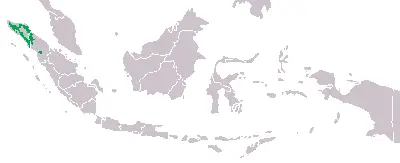Sumatran orangutan
| KINGDOM | Animalia |
| PHYLUM | Chordata |
| CLASS | Mammalia |
| ORDER | Primates |
| SUBORDER | Haplorhini |
| INFRAORDER | Simiiformes |
| FAMILY | Hominidae |
| GENUS | Pongo |
| SPECIES | Pongo abelii |
| POPULATION SIZE | 14.000 |
| LIFE SPAN | 35-50 YRS |
| TOP SPEED | 6 KM/H |
| WEIGHT | 45-90 KG |
| HEIGHT | 90-140 CM |
| LENGTH | 1.3-1.8 M |
The Sumatran orangutan (Pongo abelii ) is one of the three species of orangutans. Critically Endangered, and found only in the north of the Indonesian island of Sumatra, it is rarer than the Bornean orangutan but more common than the recently identified Tapanuli orangutan, also found in Sumatra. Its common name is based on two separate local words, “orang ” (“people” or “person”) and “hutan ” (“forest”), derived from Malay, and translates as ‘person of the forest’.
Appearance
The only great apes that live outside of Africa are orangutans, of which there are two species. The Sumatran orangutan is more endangered then the Bornean orangutan. The two differ in appearance and behaviour, with Sumatran orangutans being slightly smaller and usually having hair that is lighter coloured and orange-red, as well as a longer beard. Males develop throat pouches and fleshy pads on their cheeks but these are narrower and less pronounced than those of male Bornean orangutans.
Distribution
| CONTINENTS | Asia |
| SUBCONTINENTS | Southeast Asia |
| COUNTRIES | Indonesia |
| REGIONS | Sumatera |
| BIOGEOGRAPHICAL REALMS | Indomalayan |
| WWF BIOMES | Tropical moist forests |

Sumatran orangutans occur on Sumatra, in Indonesia, and are restricted to just the northern tip of the island. They live in primary lowland tropical forests, including mangrove, riparian forests and swamp forests.
Biome
| Forest | Rainforest |
| Riparian | Swamp Wetlands |
Climate zones
| Tropical |
Habits and Lifestyle
Sumatran orangutans lead very solitary lives, during the day moving slowly in search of food through the trees. Up to 60% of an orangutan’s time is spent foraging and eating, and, although they can occupy large home ranges, half a mile a day is the most they usually travel. At night, they build a nest for sleeping up high in the canopy out of folded branches. They are not very territorial, sharing their home ranges with others, sometimes feeding alongside other orangutans around especially abundant fruit trees. Males will stake their claim to their territory by emitting long calls, deep calls from their throat poach which echo through the forest to attract females and also to warn off potential rivals.
Diet and Nutrition
The diet of Sumatran orangutans varies seasonally, depending on the fruiting season of trees in the local area, the animals feeding when the fruit is ripe. Figs are very important in their diet. When fruit is not so available in dry seasons, Sumatran orangutans will eat vegetation such as young leaves, bark and flowers, and insects, particularly termites, ants, and crickets, and sometimes eggs.
DIET
| FRUGIVORE, HERBIVORE, |
Mating Habits
| MATING BEHAVIOR | Polygynandry |
| REPRODUCTION SEASON | December-May |
| PREGNANCY DURATION | 9 months |
| BABY CARRYING | 1 infant |
| INDEPENDENT AGE | 8-9 years |
| FEMALE NAME | female |
| MALE NAME | male |
| BABY NAME | infant |
These animals are polygynandrous; this means that two or more males mate with two or more female orangutans. Most mating occurs during rainy seasons, the heaviest fruiting months (December to May). After a gestation of about nine months, the female builds a new nest high in a tree, where her single infant is born. The young cling to its mother for safety and remains at her side during the first few years. Infants may be weaned by the age of three, but they will stay with their mother until at least the age of 8 or 9 years while being taught special skills for forest survival. Sumatran orangutans are slower breeders than other primates, with females bearing a maximum of three babies during their lifetime. Females are sexually mature by the age of 12 years and males at an average of 19 years old.
Population
Population threats
The primary threat to Sumatran orangutans is the loss of habitat. These animals have a unique vulnerability to exploitation due to their extremely long inter-birth period, usually, eight years, which makes them the world’s slowest-breeding primates. Recent political instability in the area of their habitat has led to increased illegal logging in areas that are protected, and increased capture of infants to be sold for the illegal pet trade.
Population number Orangutan
According to the IUCN Red List, the total Sumatran orangutan population is around 7,300 individuals. In addition, a population that is being established in Jambi and Riau Provinces in the Bukit Tigapuluh National Park, numbers around 70 animals and is reproducing. Overall, Sumatran orangutans’ numbers are decreasing today and they are classified as critically endangered (CR) on the list of threatened species.
Ecological niche
Sumatran orangutans have a big role in the Sumatran lowland rainforests and are therefore considered a keystone species. Orangutans are important for dispersing seeds and being consumers of a wide variety of fruit, and they also help to maintain the diversity of woody plants of the rainforest. In addition, they prune and assist in regenerating plant growth, as they choose to eat only green leaves and stalks.
Orangutans are semi-solitary primates who spend the majority of their lives alone. However, in some orangutan populations, the females will gather in groups from time to time, especially during the fruiting season, when forest food is abundant. Group activity like this allows for socialisation among orangutans, and these interactions do require communication. One of the ways that orangutans communicate is through the use of vocalisations*.
The vocalisations made by orangutans differ from those of other primates. Adult orangutans will emit long-range vocalisations to reach other individuals that are scattered throughout the dense rainforest. These vocalisations play an important role in defining individual orangutan relationships and social interactions, including for reproduction. Vocalisations are also used to convey complex emotions, such as fear, aggression, and excitement.
One of the orangutan vocalisations is the ‘grunt’, which is emitted as a low snort. At times, grunts can be heard from immature male and female orangutans as they play. In some cases, grants are also voiced by males without cheek pads as a sign they want to copulate with a dominant female. Grunts are also made by orangutans when they make contact with others.
Another vocalisation heard from orangutans is the ‘scream’, which, as its name suggests, sounds like a frightened scream or drawn-out wail. This vocalisation is typically used by baby orangutans to request food or indicates they want to suckle from their mothers. The scream is also emitted by young orangutans when they feel distressed.
A vocalisation that can be heard echoing throughout the forest is known as the ‘long call’, which is used to establish the domain of male adult orangutans with cheek pads. Long calls are sent out by adult males to attract the attention of female orangutans and to prevent other males from entering their territory. They can be heard from over 1.5 kilometres away. In some cases, adult males will make spontaneous long calls when responding to disturbances, such as being startled by a falling tree. The long call itself usually consists of three parts, an initial grunt or grumble, followed by a climax, then an ending that sounds like a low gurgle, and is quite often accompanied by a frothy or bubbly mouth. However, some orangutans will omit the grunt or grumble entirely and immediately start with the climactic part.


